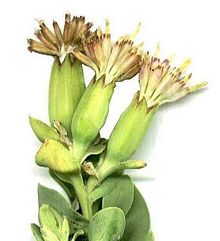Senecioneae
| Senecioneae | |
|---|---|

| |
| Lopholaena coriifolia | |
| Scientific classification | |
| Kingdom: | Plantae |
| Clade: | Tracheophytes |
| Clade: | Angiosperms |
| Clade: | Eudicots |
| Clade: | Asterids |
| Order: | Asterales |
| Family: | Asteraceae |
| Subfamily: | Asteroideae |
| Tribe: | Senecioneae Cass. |
| Genera | |
|
See text | |
Senecioneaeis the largesttribeof theAsteraceae,or the sunflower family, comprising over 150 genera and over 3,500 species.[1]Almost one-third of the species in this tribe are placed in thegenusSenecio.[2]Its members exhibit probably the widest possible range of form to be found in the entire plant kingdom, and includeannuals,minute creepingalpines,herbaceousandevergreenperennials,shrubs,climbers,succulents,trees,and semi-aquatic plants.[3]
Plants in this tribe are responsible for more livestock poisonings than all other plants combined.[4]Its members usually contain liver and kidney toxic and carcinogenic unsaturatedpyrrolizidine alkaloidsinSenecio[4]andfuranoeremophilanesinTetradymia.[3]
A number of species are well known inhorticulture.[3]
Classification
[edit]Since the time ofBentham,the "premier systematic botanist of the nineteenth century",[5] considerable efforts have been made to classify and understand the strikingmorphologicaldiversity in the Senecioneae.[2] The traditional view of the tribe has been that of one huge genusSenecioplus many other genera which exhibit varying degrees of distinctiveness.[5] Circumscription and delimitation of the tribe have experienced expansions and contractions over the decades as genera and groups of genera have been moved in and out,[3] as was the case forArnica,Liabum,Munnozia,Schistocarpha,etc. which have since then been excluded.[5] Of the several potential causes for this constant redefinition the greatest is probably that little is known about itsintergeneric relationshipsor a lack ofphylogeneticunderstanding enhanced by the other problems of conflicting clues from morphological characters, the large size of the tribe, the absence of a precise delimitation or circumscription ofSenecio[2]and the naturalness of these assemblages combined with the imprecise boundaries of the different species themselves.[5]
Many segregate genera have been recognized in recent studies, often with circumscriptions derived from selected representative species. Whether the recognition of numerous segregate genera provides a better taxonomy than treating the variation patterns asinfrageneric taxais yet unclear. A respectable case can be made for maintainingSenecioas a broad concept, at least until revisionary studies at the species level are carried out and the results subjected to critical analyses.[5] Most genera that have been removed from the Senecioneae in the broadest sense have come to rest within theLiabeaeor within a broadly circumscribedHeliantheae(e.g., allies in theArnicinae,Chaenactidinae,orMadiinae;Haploesthesin theFlaveriinae;andRaillardellaand allies in theMadiinae). Additional information may be found inB. G. Baldwinet al. (2002),H. Robinson(1981),B. Nordenstam(1977–1978) andK. Bremer(1994).[3]
Genera
[edit]Senecioneae genera recognized by the Global Compositae Database as of October 2022[update]:[1]
- Abrotanella
- Acrisione
- Adenostyles
- Aequatorium
- Aetheolaena
- Angeldiazia
- Antillanthus
- Arbelaezaster
- Arnoglossum
- Arrhenechthites
- Austrosynotis
- Bafutia
- Barkleyanthus
- Bedfordia
- Bethencourtia
- Blennosperma
- Bolandia
- Brachionostylum
- Brachyglottis
- Cabreriella
- Cacaliopsis
- Cadiscus
- Capelio
- Caucasalia
- Caxamarca
- Centropappus
- Charadranaetes
- Chersodoma
- Cineraria
- Cissampelopsis
- Crassocephalum
- Cremanthodium
- Crocidium
- Culcitium
- Curio
- Dauresia
- Delairea
- Dendrocacalia
- Dendrophorbium
- Dendrosenecio
- Dicercoclados
- Digitacalia
- Dolichoglottis
- Dolichorrhiza
- Dorobaea
- Doronicum
- Dresslerothamnus
- Ekmaniopappus
- Elekmania
- Emilia
- Emiliella
- Endocellion
- Erechtites
- Eriotrix
- Euryops
- Farfugium
- Faujasia
- Faujasiopsis
- Garcibarrigoa
- Graphistylis
- Gymnodiscus
- Gynoxys
- Gynura
- Haastia
- Hasteola
- Herodotia
- Herreranthus
- Hertia
- Hoehnephytum
- Homogyne
- Hubertia
- Humbertacalia
- Ignurbia
- Io
- Iocenes
- Iranecio
- Ischnea
- Jacmaia
- Jacobaea
- Jessea
- Kleinia
- Lachanodes
- Lasiocephalus
- Lamprocephalus
- Leonis
- Lepidospartum
- Ligularia
- Ligulariopsis
- Lopholaena
- Lordhowea
- Luina
- Lundinia
- Mattfeldia
- Mesogramma
- Mesoneuris
- Mikaniopsis
- Miricacalia
- Misbrookea
- Mixtecalia
- Monticalia
- Nelsonianthus
- Nemosenecio
- Nesampelos
- Nordenstamia
- Odontocline
- Oldfeltia
- Oligothrix
- Oresbia
- Othonna
- Packera
- Papuacalia
- Paracalia
- Parafaujasia
- Paragynoxys
- Parasenecio
- Pentacalia
- Pericallis
- Petasites
- Phaneroglossa
- Pippenalia
- Pittocaulon
- Pladaroxylon
- Pojarkovia
- Psacaliopsis
- Psacalium
- Psednotrichia
- Pseudogynoxys
- Pseudojacobaea
- Rainiera
- Robinsonecio
- Robinsonia
- Roldana
- Rugelia
- Scapisenecio[6]
- Scrobicaria
- Senecio
- Senecurio
- Shafera
- Sinacalia
- Sinosenecio
- Solanecio
- Steirodiscus
- Stenops
- Stilpnogyne
- Syneilesis
- Synotis
- Talamancalia
- Telanthophora
- Tephroseris
- Tetradymia
- Traversia
- Trineuron
- Tussilago
- Urostemon
- Villasenoria
- Xenophyllum
- Yermo
- Zemisia
References
[edit]- ^abCompositae Working Group (CWG) (2023)."Senecioneae Cass."Global Compositae Database.Retrieved2023-06-03.
- ^abcPelser, Pieter B; Nordenstam, Bertil; Kadereit, Joachim W.; Watson, Linda E. (November 2007). "An ITS phylogeny of tribe Senecioneae (Asteraceae) and a new delimitation ofSenecioL. ".Taxon.56(4).International Association for Plant Taxonomy(IAPT): 1077–14E(–1062).doi:10.2307/25065905.JSTOR25065905.
- ^abcdeBarkley, T.M.;Brouillet, L.;Strother, J.L. (2006)."Senecioneae".In Flora of North America Editorial Committee (ed.).Flora of North America North of Mexico (FNA).Vol. 20. New York and Oxford: Oxford University Press.Retrieved2008-04-14– via eFloras.org,Missouri Botanical Garden,St. Louis, MO &Harvard University Herbaria,Cambridge, MA.
- ^abPieter B. Pelser, Barbara Gravendeel and Ruud van der Meijden (2002)."Tackling speciose genera: species composition and phylogenetic position of Senecio sect. Jacobaea (Asteraceae) based onplastid and nrDNA sequences".American Journal of Botany.89(6): 929–939.doi:10.3732/ajb.89.6.929.PMID21665692.
- ^abcdeBarkley, T. M. (February 1985). "Generic Boundaries in the Senecioneae".Taxon.34(1).International Association for Plant Taxonomy(IAPT): 17–21.doi:10.2307/1221558.JSTOR1221558.
- ^Schmidt-Lebuhn, Alexander N.; Zeil-Rolfe, Isabel; Lepschi, Brendan & Gooden, Ben (2020). "Expansion ofLordhowea,and a new genus for scapose, alpine Australian species of Senecioneae (Asteraceae) ".Taxon.69(4): 756–777.doi:10.1002/tax.12321.
External links
[edit] Media related toSenecioneaeat Wikimedia Commons
Media related toSenecioneaeat Wikimedia Commons Data related toSenecioneaeat Wikispecies
Data related toSenecioneaeat Wikispecies
